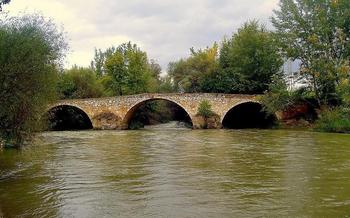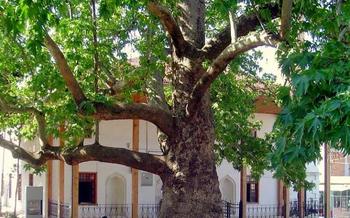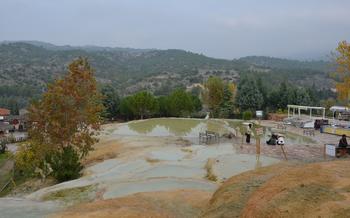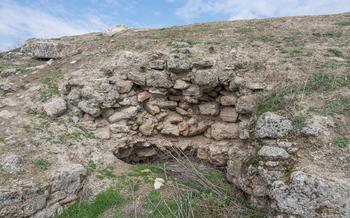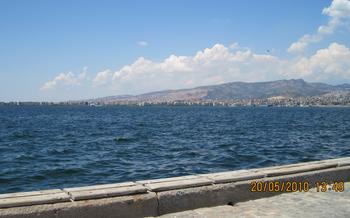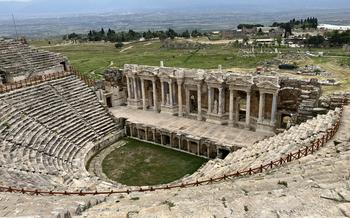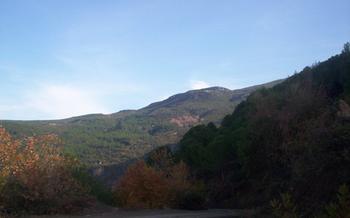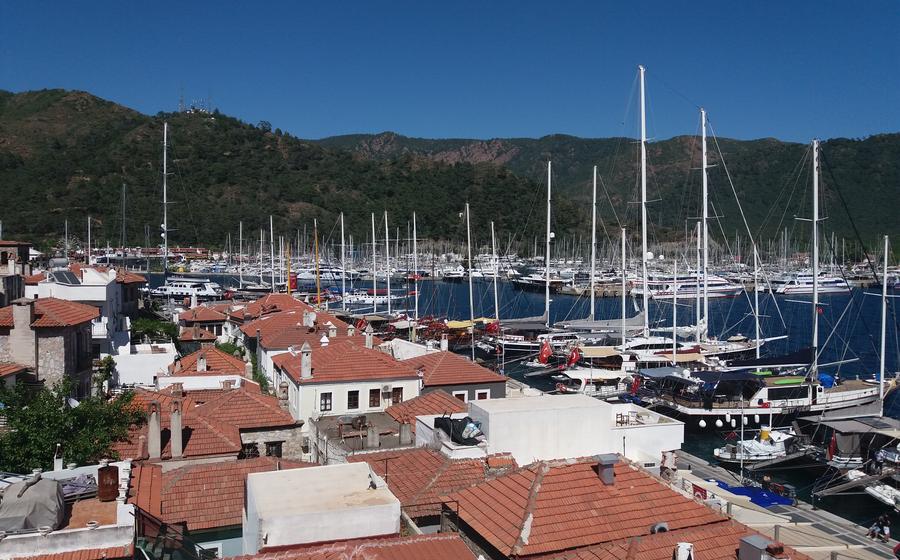
Pamukkale and Hierapolis
- Pamukkale and Hierapolis: A Unique Destination
- Marvelous Travertines of Pamukkale
- Hierapolis, an Ancient City of Wonders
- Pamukkale's Stunning Views
- Hierapolis Museum: A Treasure Trove of Ancient History
- Other Attractions in Pamukkale
- Planning Your Visit
- Entrance Fees and Hours
- Accommodation and Dining Options
- Essential Tips for Visitors
- Local Culture and Traditions
- Insider Tip: Unveiling Hidden Treasures
Pamukkale and Hierapolis: A Unique Destination
Pamukkale, a natural wonder of Turkey, is a unique blend of history, nature, and culture. The site is home to cascading travertine terraces that resemble cotton balls, earning it the name "Cotton Castle." Hierapolis, an ancient city built on top of these terraces, is a testament to the region's rich past. The fusion of natural and historical wonders has made Pamukkale and Hierapolis a UNESCO World Heritage Site. Situated in the southwestern province of Muğla, this captivating destination is easily accessible by road or air, making it a must-visit for travelers seeking an extraordinary experience.
Marvelous Travertines of Pamukkale
Pamukkale's travertine terraces are a remarkable natural wonder, formed over millennia by the deposition of calcium carbonate from hot springs. The cascading effect of the terraces, resembling a frozen waterfall, creates a mesmerizing spectacle. The unique geological process that led to their formation involves the interaction of warm water rich in dissolved minerals with the surrounding environment, resulting in the precipitation of calcium carbonate and the growth of these spectacular formations.
The terraces shimmer in shades of white and beige, creating a striking contrast with the surrounding landscape. The travertines are not only visually stunning but also hold immense scientific value. Understanding their formation and composition provides insights into geological processes and the role of water in shaping landscapes. Conservation efforts are crucial to preserve this unique natural heritage and ensure its protection for future generations.
Hierapolis, an Ancient City of Wonders
Hierapolis, an ancient city established in the 2nd century BC, stands as a testament to the grandeur and ingenuity of the past. Once a significant center for trade and religion, Hierapolis boasts an array of well-preserved ruins that offer a glimpse into its glorious history. Among the most notable structures are the imposing Roman theater, with its impressive seating capacity and intricate carvings, and the Temple of Apollo, dedicated to the revered Greek god. The city also features a well-preserved necropolis, with hundreds of elaborate tombs and sarcophagi, providing insights into the burial practices and beliefs of the ancient inhabitants. The significance of Hierapolis lies not only in its architectural marvels but also in its strategic location, situated along important trade routes and serving as a vital link between the Roman Empire and the East.
Pamukkale's Stunning Views
The travertine terraces of Pamukkale offer breathtaking panoramic views that are not to be missed. Ascend to the top of the cascading terraces and be rewarded with a vista that stretches for miles, encompassing the surrounding countryside and the distant mountains. The play of light and shadow on the white travertines creates a mesmerizing effect, especially during sunrise and sunset. Capture the beauty of the landscape with your camera or simply soak in the stunning scenery, allowing the tranquility of the surroundings to wash over you. Whether you're a nature enthusiast, a photographer, or simply someone who appreciates breathtaking vistas, the panoramic views from Pamukkale are sure to leave an unforgettable impression.
Hierapolis Museum: A Treasure Trove of Ancient History
Housed within the ancient city of Hierapolis, the Hierapolis Museum stands as a testament to the rich history and culture of this remarkable site. As you step inside, you'll be greeted by a treasure trove of artifacts that offer a glimpse into the lives and times of the people who once called this place home.
From intricate sculptures and mosaics to pottery, jewelry, and inscriptions, the museum's collection is a fascinating journey through the ages. Admire the finely crafted marble statues that once adorned the city's temples and public spaces, each one telling a story of the city's artistic prowess. Marvel at the delicate mosaics that depict scenes from mythology and everyday life, offering a glimpse into the beliefs and customs of the ancient inhabitants.
Don't miss the impressive collection of coins that provide insights into the economic and political history of Hierapolis. Study the inscriptions that reveal the names, titles, and accomplishments of the city's rulers and citizens. These written records offer a glimpse into the social and political structures of ancient Hierapolis.
The Hierapolis Museum is a must-visit for anyone interested in exploring the depths of this ancient city's history and culture. As you wander through its galleries, you'll gain a deeper understanding of the lives and achievements of the people who once thrived within these walls.
Other Attractions in Pamukkale
Beyond the travertines and Hierapolis, Pamukkale offers a wealth of additional attractions to explore. The ancient Agora marketplace, a bustling center of trade in Roman times, offers a glimpse into the daily life of the city's inhabitants. The well-preserved Roman theater, with its impressive acoustics, hosts cultural performances and events.
For those seeking a unique perspective, hot air balloon rides over Pamukkale provide breathtaking aerial views of the travertines and the surrounding countryside. The vibrant colors of the hot air balloons against the backdrop of the white terraces create a mesmerizing sight.
Nature enthusiasts can embark on hiking trails that wind through picturesque valleys and offer panoramic vistas of the region. Gentle nature walks allow visitors to immerse themselves in the tranquility of the surroundings and encounter the diverse flora and fauna that call Pamukkale home.
Picnics amidst the natural beauty of Pamukkale are a delightful way to spend a leisurely afternoon. Designated picnic areas provide a perfect setting to savor local delicacies while enjoying the serene ambiance of the travertines.
Planning Your Visit
To make the most of your trip to Pamukkale and Hierapolis, careful planning is essential. The best time to visit is during the shoulder seasons (April-May and September-October) when the weather is pleasant, and the crowds are smaller. Summer months can be scorching, while winter temperatures can dip below freezing, making exploration less enjoyable.
For a comprehensive experience, plan to spend at least two days in the area. This will allow ample time to explore the travertines, visit Hierapolis, and soak in the famous Cleopatra's Pool. Several transportation options are available, including buses, trains, and domestic flights. From major cities like Istanbul and Ankara, direct flights to Denizli, the closest airport to Pamukkale, are available.
Entrance Fees and Hours
Visiting Pamukkale and Hierapolis comes with entrance fees, ensuring the preservation and maintenance of this remarkable site. Currently, the admission price for both attractions is 250 TL for international visitors and 80 TL for Turkish citizens. These fees contribute to ongoing conservation efforts and help protect the travertines and ancient ruins for future generations.
Pamukkale and Hierapolis are open to visitors daily, providing ample opportunities to explore their wonders. The operating hours are from 8:00 AM to 8:00 PM during the summer season (April to October) and from 8:00 AM to 5:00 PM during the winter season (November to March). It's worth noting that these hours may vary slightly depending on seasonal changes, so it's advisable to check the official website or local authorities for the most up-to-date information.
To avoid large crowds and enjoy a more serene experience, it's recommended to plan your visit during the shoulder seasons (spring and autumn) or on weekdays. The peak tourist season in Pamukkale typically runs from June to August, so if you prefer a quieter atmosphere, consider visiting outside these months.
Accommodation and Dining Options
Pamukkale offers a diverse range of accommodation options to suit every budget and preference. From budget-friendly guesthouses to luxurious hotels with panoramic views of the travertines, there's something for every traveler. For a truly immersive experience, consider staying in one of the charming cave hotels built into the hillside, offering unique and unforgettable accommodations.
When it comes to dining, Pamukkale's culinary scene is as diverse as its landscape. From traditional Turkish cuisine to international flavors, there's something to satisfy every palate. Sample local delicacies such as keşkek, a hearty dish made with lamb and wheat, or indulge in fresh seafood at one of the many waterfront restaurants. For a unique dining experience, head to one of the rooftop restaurants offering panoramic views of the travertines while you savor your meal.
Essential Tips for Visitors
When visiting Pamukkale and Hierapolis, certain essential tips should be kept in mind to ensure a safe and enjoyable experience.
-
Appropriate Footwear: Given the uneven terrain and slippery surfaces, it's crucial to wear comfortable and supportive shoes with good traction to prevent accidents.
-
Sun Protection: The region's hot climate demands adequate sun protection. Wear sunscreen, sunglasses, and a hat to shield yourself from the intense sun, especially during midday hours.
-
Hydration: Staying hydrated is essential to combat the heat and prevent dehydration. Carry a refillable water bottle and stay hydrated throughout your visit.
-
Respect for the Site: Pamukkale and Hierapolis are UNESCO World Heritage Sites, and it's vital to respect their cultural and historical significance. Refrain from defacing or damaging any structures, and avoid climbing or walking on the travertines to preserve their natural beauty.
Local Culture and Traditions
As you explore Pamukkale and Hierapolis, it's important to be respectful of the local culture and traditions. The region is home to a warm and welcoming people who are proud of their heritage. Take the time to interact with locals, learn about their way of life, and share stories. Remember to dress modestly, especially when visiting religious sites. Respect the local customs and traditions, and avoid any behavior that may be considered offensive. Embracing the local culture is a crucial part of having a truly immersive and fulfilling experience in Pamukkale and Hierapolis.
Insider Tip: Unveiling Hidden Treasures
To truly immerse yourself in the wonders of Pamukkale and Hierapolis, consider visiting during the off-peak seasons, typically from October to April. This allows you to avoid the throngs of tourists and bask in the tranquility of the site. Moreover, exploring nearby attractions like the Karahayit hot springs and the ancient city of Aphrodisias, known for its exquisite sculptures, will enhance your understanding of the region's rich history and cultural heritage. If you seek a truly immersive experience, enlist the services of local guides who can provide invaluable insights and anecdotes, bringing the past to life and ensuring you make the most of your visit to Pamukkale and Hierapolis.


